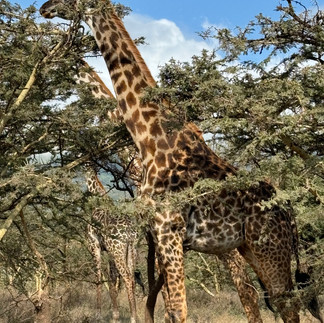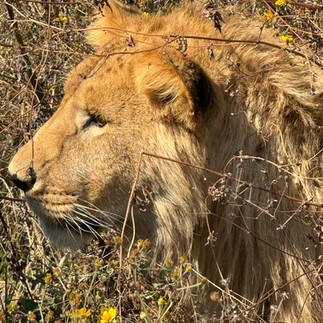A Tanzanian Treasure
- Barbara Stark-Nemon
- Jul 1, 2024
- 4 min read

A recent trip to Tanzania is the first extended adventure in at least a decade during which I didn’t have a novel-in-progress on my mind— no outright research, no listening for inflections of a foreign language for dialog, no attempts to capture the sights and smells of a landscape or village road for a setting.
I went to Africa because it was a bucket list trip for my husband and my son, and the timing worked for both families. I left Africa in love with the country of Tanzania, and reminded of the value new sights, sounds, and tastes provide in reframing life perspectives and recharging internal batteries. I am so grateful for those reminders.
The trip promised to be physically taxing, (it was) and we wanted to do it while we still could. I will admit to some trepidation about 1. Attempting any kind of hike on Mt. Kilimanjaro, 2. Spending two weeks in a country where we were warned not to drink the water and not to eat fresh fruits or vegetables. 3. Traveling as a privileged white person to a country where many of the citizens could not afford to reside in the comfortable conditions that we would. I don’t like feeling like a voyeur.
What I forgot in all this pre-trip anxiety is that travel to wonder-full places is invariably expansive, perspective altering and fulfilling. Check, check, and check. Due to the efforts of our travel agent, Red Knot Travel, and my son Adam’s hard work customizing our trip to meet the needs of two 74-year-olds, two thirty-somethings, and five children ranging in age from 8 to 15, our trip was active, captivating but not overly exhausting. I am so grateful for their efforts.
Kilimanjaro.

Tanzania lies on the south-eastern coast of Africa, south of Kenya and Uganda, and north of Zambia, Malawi and Mozambique. Over 30% of the land in Tanzania is in National Park or Conservation areas. The famous Mt. Kilimanjaro is included in that preserved area. Our farm-stay lodging abutted the national forest so our access to the park was close, but included a bone-jarring hour-long climb in a land cruiser to reach the Shira Plateau where our hike began.
As Ernest Hemingway was my “gateway drug’ into my love of novels, Kilimanjaro has always held a romantic place in my heart, and the knowledge gained from our wonderful guide on the 13 km hike only deepened that attraction. The name Kilimanjaro comes from a corruption of the local tribal (Chagga) name kilime kyaro, meaning “mountain of whiteness” or “mountain that defeats the caravan.”
German occupiers elided the words into one.
As a source of water for the entire surrounding area, and as the highest freestanding mountain in Africa at 19,000 ft, “Kili,” as it’s nicknamed locally, was not to be climbed by the Chagga. Its power as a holy site includes the belief that the spirits of ancestors reside there and that it is a symbol of strength, courage and beauty.
We were lucky to see Kili in its full magnificent clarity on the sunny day of our climb. We hiked across the Shira plateau, ascending only 2,000 feet across 13 km. The path was rough but it was gorgeous and filled us with the famed wonder of the place.
Ngorongoro and Serengeti
Tanzanian people come from more than 120 tribes, each with their own language or dialect, and tribal identification is still very strong. Swahili is the national language. The overarching culture of warmth, welcome, and deep respect for the land was evident everywhere. We quickly learned the greeting “Jambo.” N.B. Don’t try to bring a plastic bag into Tanzania. Not allowed!
When we left the Chagga-dominated area around Arusha and Kilimanjaro for Ngorongoro and the Serengeti, we found ourselves in an area inhabited by the Masaii and our visit to one of their villages informed us how they maintain traditional lifestyle while still adjusting to the modern world.
The profound wonder of the Ngorongoro Conservation area and Serengeti National Park lies in diverse physical beauty and the magnificent array of animals. The end of the rainy season, and the very beginning of the dry season meant the grasses were still green, water plentiful, and lots of young and baby animals to see. The weather was perfect.
We were able to observe a portion of the Great Migration of wildebeests and zebras as they headed north, combining their species strengths to bolster their weaknesses. (a lesson) We saw herds of elephants and giraffes. We saw lions lazing along the road. We saw cheetahs, rhinoceros and hippos. And colobus monkeys and baboons. And more birds than I can name. Candelabra cactus, acacia and bao bao trees. We learned there are 46 types of bananas in Tanzania! We saw UNESCO monuments designating archeological finds of the earliest humans.
Zanzibar


Our last two days were R and R at a resort on the famed beaches of this island that is part of Tanzania. (The president of Tanzania is a woman from Zanzibar!)
We shared all this with five children who were as gob smacked as we were. We got out of our comfort zones together. We were enthralled together. It was a wonder I will treasure.
P.S. I may never be able to go to a zoo again…..
































































Forget the common and embrace passionate escapades of our stunning Escorts Near Svelte Hotel. Discretion disallowed, our Call Girls Near Svelte Hotel will be there to grant your wish. Find Escorts Service in Svelte fascinating and our premium Escorts Service Near Svelte Hotel Delhi.
link link link link link link link link link link link link link link link link link link link link link link link link link link link link link link link link link link link link link link link link link link link link link link link link link link link link link link link link link link link link link link link link link link link link link link link link link link link link link link link link link link link link link link link link link link link link link link link link link link link link
Nothing exudes confidence like a Mens Biker Leather Jacket. Crafted from premium leather, this jacket ensures both style and protection. Biker Jacket offers the best designs for modern riders and fashion lovers. Pair it with jeans and boots for a timeless look. Get yours today and ride in style!
Elevate your fan wardrobe with a striking Chicago Bulls Varsity Jacket from Team Jackets. It’s the ultimate blend of team pride and streetwear chic.
Explore the timeless charm of the Yellowstone Vest at Western Apparel. With a perfect blend of quality and style, this piece is a fan-favorite for a reason.